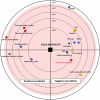Corruption kills: estimating the global impact of corruption on children deaths
- PMID: 22073233
- PMCID: PMC3206868
- DOI: 10.1371/journal.pone.0026990
Corruption kills: estimating the global impact of corruption on children deaths
Abstract
Background: Information on the global risk factors of children mortality is crucial to guide global efforts to improve survival. Corruption has been previously shown to significantly impact on child mortality. However no recent quantification of its current impact is available.
Methods: The impact of corruption was assessed through crude Pearson's correlation, univariate and multivariate linear models coupling national under-five mortality rates in 2008 to the national "perceived level of corruption" (CPI) and a large set of adjustment variables measured during the same period.
Findings: The final multivariable model (adjusted R(2)= 0.89) included the following significant variables: percentage of people with improved sanitation (p.value<0.001), logarithm of total health expenditure (p.value = 0.006), Corruption Perception Index (p.value<0.001), presence of an arid climate on the national territory (p = 0.006), and the dependency ratio (p.value<0.001). A decrease in CPI of one point (i.e. a more important perceived corruption) was associated with an increase in the log of national under-five mortality rate of 0.0644. According to this result, it could be roughly hypothesized that more than 140000 annual children deaths could be indirectly attributed to corruption.
Interpretations: Global response to children mortality must involve a necessary increase in funds available to develop water and sanitation access and purchase new methods for prevention, management, and treatment of major diseases drawing the global pattern of children deaths. However without paying regard to the anti-corruption mechanisms needed to ensure their proper use, it will also provide further opportunity for corruption. Policies and interventions supported by governments and donors must integrate initiatives that recognise how they are inter-related.
Conflict of interest statement
Figures


References
-
- Transparency International. Global corruption report 2006: Corruption and Health. Berlin: Transparency International (TI); 2006.
-
- Vian T. Review of corruption in the health sector: theory, methods and interventions. Health Policy Plan. 2008;23:83–94. - PubMed
-
- Abed GT, Gupta S. Governance, Corruption, & Economic Performance. Washington, D.C: International Monetary Fund; 2002.
-
- World Bank. Helping countries combat corruption: progress at the World Bank since 1997. Washington, DC: World Bank; 2000.
-
- Azfar O, Gurgur T. Does Corruption Affect Health and Education Outcomes in the Philippines? College Park: Institutional Reform and Informal Sector; 2008.
Publication types
MeSH terms
LinkOut - more resources
Full Text Sources

